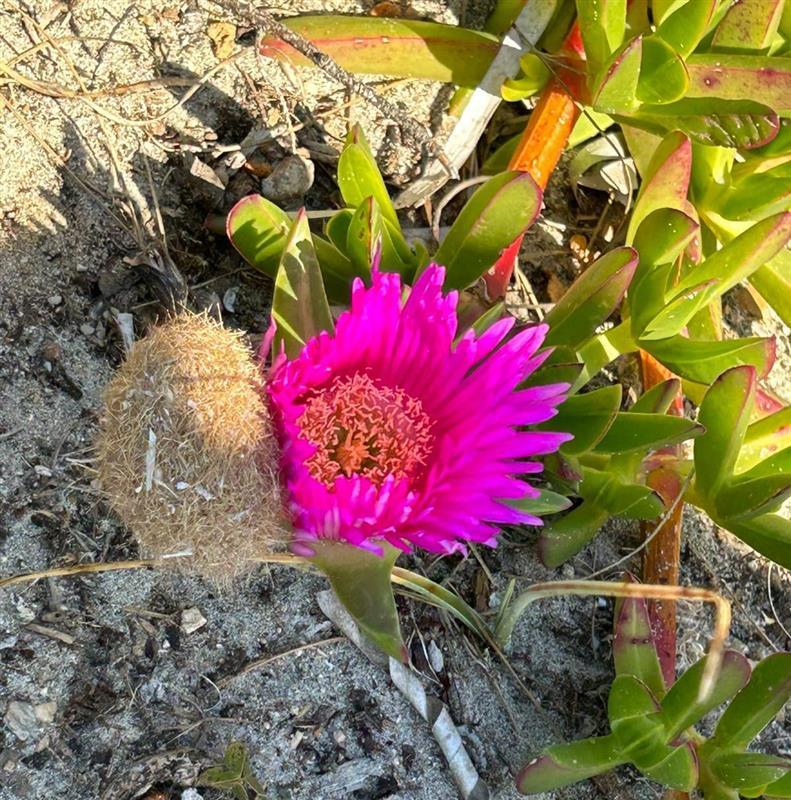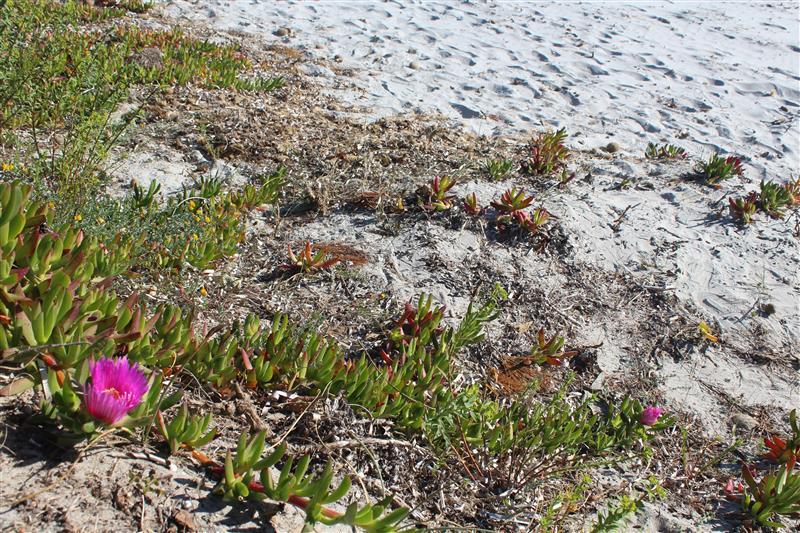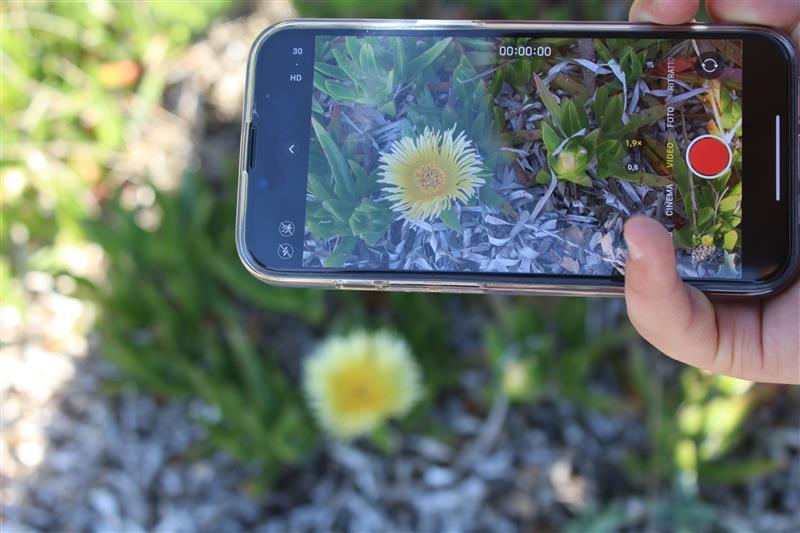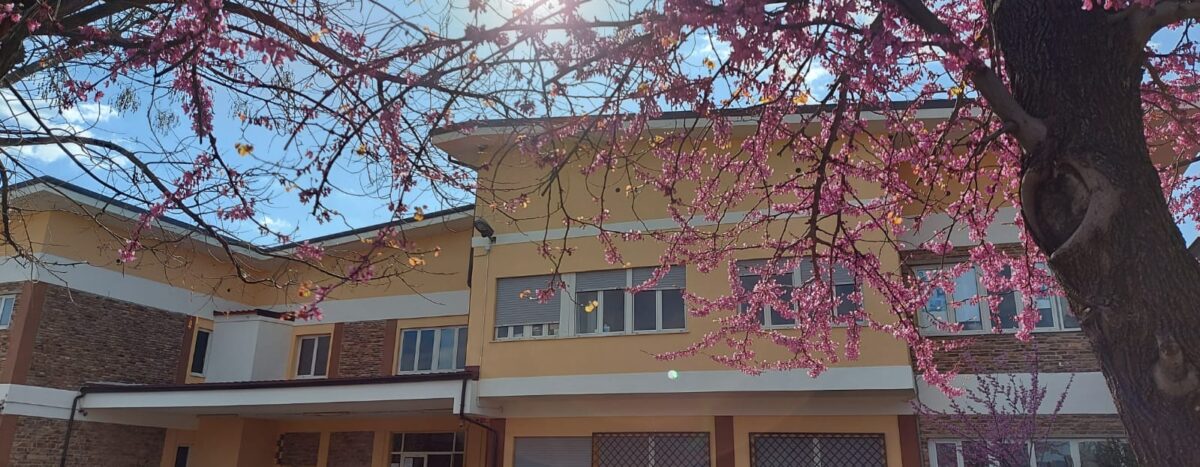Beautiful this flower right? We really think so. But unfortunately it does not favor biodiversity.

The flora of dune ecosystems usually does not tolerate the reintegration of alien species. In some cases they are real weeds, even of exotic origin; such as the case we are going to analyze.

It’s that of the Carpobrotus it’s know as the Hottentot fig, it’s a well-know case. This flower is native to the coastal areas of South Africa and has become naturalized in many coastal areas of the world and is even considered as a weed, as it spreads very quickly by carpeting the coasts and destroying the native vegetation. For this reason, the Hottentot fig is a species listed by the IUCN in the list of weeds.
Most of the species grows on sandy soils in coastal areas and is also used as a beach covering, but above all to strengthen sloping soils. This peculiarity, however, is not very favorable to other plant species; in fact its very extensive roots do not allow other plants to grow close to it.
Carpobrotus can represent a serious problem for the environment and biodiversity. There are some possible remedies to prevent its spread:
- Manual grubbing: this is the most effective solution, but also the most demanding. The removal of the plant must be done with care, in order to completely eliminate all the parts.
- Ground cover: Covering the ground with special fabrics can prevent the growth of the Hottentot fig tree, preventing them from getting the sunlight and water they need.
- Prevention: it is important to inform and sensitize the population on the importance of not introducing invasive species into the environment.
As absurd as it may seem to have to destroy such a beautiful flower, it is inevitable if we are to allow biodiversity to be preserved. All animal and plant species have the right to live in their territory, man cannot change the course of nature by looking for shortcuts and solutions that are too simple. Let’s use our brains and hearts to save the planet.

(Sources: Wikipedia, Letsgo giglio, la casa delle grasse, chat GPT, Quaderno Docenti)
Cancellu Cristian, Diouf Adja, Meloni Sara, Spanu Maria Eleonora
L’apparenza inganna
Bello questo fiore vero? Pensiamo proprio di si. Ma purtroppo non favorisce la biodiversità.
La flora degli ecosistemi dunale di norma non tollera l’inserimento di specie aliene. In alcuni casi si tratta di vere e proprie infestanti, anche di origine esotica; come il caso che stiamo andando ad analizzare.
Quello dei Carpobrotus, o più conosciuto come fico degli Ottentotti, è un caso molto noto. Questo fiore è originario delle aree costiere del Sudafrica, si è naturalizzato in molte zone costiere del mondo ed è addirittura considerato come infestante, in quanto si diffonde molto velocemente tappezzando le coste e distruggendo la vegetazione autoctona.
Per questo, il fico degli Ottentotti è una specie elencata dalla IUCN nell’elenco delle piante infestanti.
La maggior parte della specie cresce su terreni sabbiosi delle aree costiere e viene anche utilizzata come rivestimento per spiagge, ma soprattutto per rafforzare terreni pendenti. Questa particolarità, però, non è molto favorevole ad altre specie vegetali; infatti le sue radici molto estese non permettono alle altre piante di crescergli vicino.
Il Carpobrotus può rappresentare un grave problema per l’ambiente e la biodiversità. Esistono alcuni possibili rimedi per evitarne la diffusione:
- estirpazione manuale: questa è la soluzione più efficace, ma anche la più impegnativa. La rimozione della pianta va effettuata con cura, in modo da eliminarne completamente tutte le parti.
- Copertura del terreno: la copertura del terreno con tessuti speciali può prevenire la crescita del fico degli Ottentotti, impedendo loro di ricevere la luce solare e l’acqua di cui hanno bisogno.
- Prevenzione: è importante informare e sensibilizzare la popolazione sull’importanza di non introdurre specie invasive nell’ambiente.
Per quanto possa sembrare assurdo dover distruggere un fiore così bello, è inevitabile se vogliamo permettere che la biodiversità venga preservata. Tutte le specie animali e vegetali hanno il diritto di vivere nel loro territorio, l’uomo non può cambiare il corso della natura cercando scorciatoie e soluzioni troppo semplici. Usiamo il cervello e il cuore per salvare il pianeta.
(Sources: Wikipedia, Letsgo giglio, la casa delle grasse, chat GPT, Quaderno Docenti)
Cancellu Cristian, Diouf Adja, Meloni Sara, Spanu Maria Eleonora

